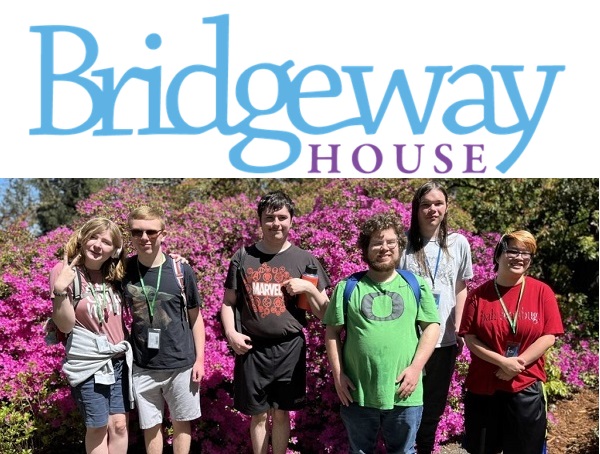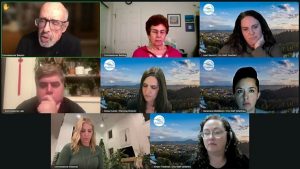Stories of Bridgeway House: Sherri Phillips and Hartley
6 min read
Presenter: June 18 is Autistic Pride Day, and we’re visiting with the instructional assistants at the Camp Creek campus of Bridgeway House. Hartley is the lead IA.
Hartley: My son is also autistic. So it was really exciting to me to see the support that families were getting and be able to be part of that. And learn, like I learned so many things learning and growing for things at home that I can use in the classroom too. So, it kind of goes both ways.
[00:00:26] A lot of communication skills. Just a lot of the trainings and things that I can go home and use to not only better communicate, but you know, my patience level has improved. And just that different strategies I can try, but communication really, really has been the biggest thing. Just different ways to communicate.
[00:00:45] There’s one that we use if it’s taking a moment for a student to answer or something and try, don’t try to rush it. You know, it’s like we count, I count eight pink elephants in my head. You know, I learned that at Bridgeway, ’cause it gives time for them to process and then I’m not getting, ‘Okay, let’s try, let’s go, give me an answer.’
[00:01:05] And so those are things that I can go home and use to my own family. And it’s been great. You know, it’s such a great experience to be able to work out there with these kids.
[00:01:14] Presenter: Sherri Phillips:
[00:01:16] Sherri Phillips: And I’m Sherri Phillips and I’m also an IA at the Camp Creek location, and I teach science in three different classrooms.
[00:01:22] I came from a public school setting where you had 42 kids in a class to a setting where you had eight to 10 in the class. And we’re so much better able to meet needs where you couldn’t in a public school setting, especially for special needs kids.
[00:01:38] Bridgeway is individualized. Each student gets what they need, where they’re at. And the public school system is not that way. You’re going to just stick to the program, you have to teach it this way. And every kid has to learn it this way.
[00:01:52] And at Bridgeway, we teach them in any way that they need learning. Each, each student is a student. They’re not part of a streamlined system.
[00:02:03] We use nonviolent communication, so we’re really focused on needs and feelings: Are you feeling this because you need this right now? They’re not made to do anything. We simply give it a different approach.
[00:02:17] I teach science, so we bring out hands-on stuff and I don’t tell them what they’re supposed to learn. I wish them to ask questions. And then we can talk about what they’re learning instead of just telling them what to do.
[00:02:30] Presenter: Hartley:
[00:02:31] Hartley: You know, if they’re struggling with something, we can take it a lot slower than you can at a public school. So, you know, if we need to do the same worksheet five times in a row to get a concept, we can, it’s okay. You know, can put it away if we need to and do something completely different or just, you know, go take a break: ‘Okay we’re going to do this today.’ We’re just going to go take a walk. We’re going to go, you know, look at something else.
[00:02:54] We’re going to go do some sensory things to help you get into a good space so that you’re ready to sit at your desk and do what you need to do, versus at a public school where they just have to sit all day and do their work and, you know, they’re going for grades. We don’t do grades. We measure progress and are they meeting these certain goals.
[00:03:12] And a lot of them are socially-based goals versus academic-based goals.
[00:03:17] Presenter: Sherri Phillips.
[00:03:18] Sherri Phillips: Social goals, it’s huge. It’s a huge thing now, learning to take turns. Learning to acknowledge your peers, we’re able to give them the words they need to help them get there. And over time they do get there and it’s really exciting to see that when they do.
[00:03:34] Presenter: Hartley shared just one of many such stories from Bridgeway House.
[00:03:38] Hartley: The student used to not be able to do anything. They would just yell at you all day and the student wouldn’t leave the classroom. And now the student is going to the gym with us, going outside with us, getting all their work done. And it’s been incredible to watch the progress and the whole school when they see the student like going places with us, they’re like, is that? Is that that student, are they going with you?
[00:04:02] And so it’s just the coolest thing to watch when they’ve come in at, how hard, you know, through the years it’s been. And then just suddenly it’s just like, man, all of a sudden, you know, there’s a light bulb moment where things just start happening and you’re like, all that work that we’ve put in and all that work that they’ve put in just kind of comes together and it’s just the most incredible thing to see.
[00:04:23] And you’re like, ‘Oh my gosh.’
[00:04:25] Presenter: Sherri Phillips:
[00:04:26] Sherri Phillips: It’s fun to be a part of all that. It’s just amazing to watch the growth and see that spark come through, that we work so much on building relationships with these kids that they’re willing to try new things. Because we’ve got that trust built up. And I think that’s one of the biggest things that makes the difference is there’s a true connection.
[00:04:49] Hartley: Yeah. We work really hard to build a rapport with students before we try to push any academics or demands or anything on. We try really, really hard to just get to know them, get to know what they like, get them used to us. And it’s incredibly helpful when you do have to start making demands on them. you know?
[00:05:10] Sherri Phillips: Yeah. Even the ones that don’t necessarily like you, they’re still going to do the work and they’re going to come to you when they need help. And they need to feel good about themselves.
[00:05:20] Hartley: And that’s the thing too, is not just watching their progress, but like watching them start to feel good about themselves and start to like be happy, smiling, you know. They come in depressed and down, not talking to anyone, and now they’re smiling and they’re excited and they can’t wait to come and see friends.
[00:05:36] Sherri Phillips: And they notice who’s gone in the classroom immediately: ‘Where’s so and so? Where’s so and so?’ Because they’re used to them being there and they consider them friends.
[00:05:45] And their parents are finally seeing success. And now they have hope that their children are cared for and loved. And that we’re doing our best so that they can do their best at home.
[00:05:57] Hartley: I don’t know of any other programs like Bridgewood really around here and, you know, so many parents, there’s just no other options, you know, and they, they feel like they’re doing this alone. And so us being able to be there, we, we don’t just provide support for the parents, we can also point them in the right direction for other services that they need.
[00:06:19] And a lot of us (like me) have autistic children and so we’ve been there, we’ve walked some of the same paths that they’re walking, so we can provide support that way too. And sometimes they just need a hug or you know, a shoulder to cry on.
[00:06:33] And so, yeah, we’re not just supporting the students, we’re supporting the parents, their whole families. And so losing Bridgeway House would be pretty devastating.
[00:06:42] Sherri Phillips: We love these kids and we don’t want to give up on them. And losing Bridgeway would be giving up on a lot of kids that have bright futures.
[00:06:53] Presenter: We’ve been visiting with two instructional assistants from the Camp Creek location, Sherri Phillips and Hartley. Bridgeway House started as parents providing mutual aid in Patricia Wigney’s living room. It’s now a school serving 90 students from 17 school districts. You can donate to Bridgeway House through their website, Bridgewayhouse.org, or call (541) 345-0805.
During summer break, calls to Bridgeway House will be automatically transferred to school admin team cell phones. For faster service, call the cell phones directly: (541) 743-5159 and (505) 930-6910.




